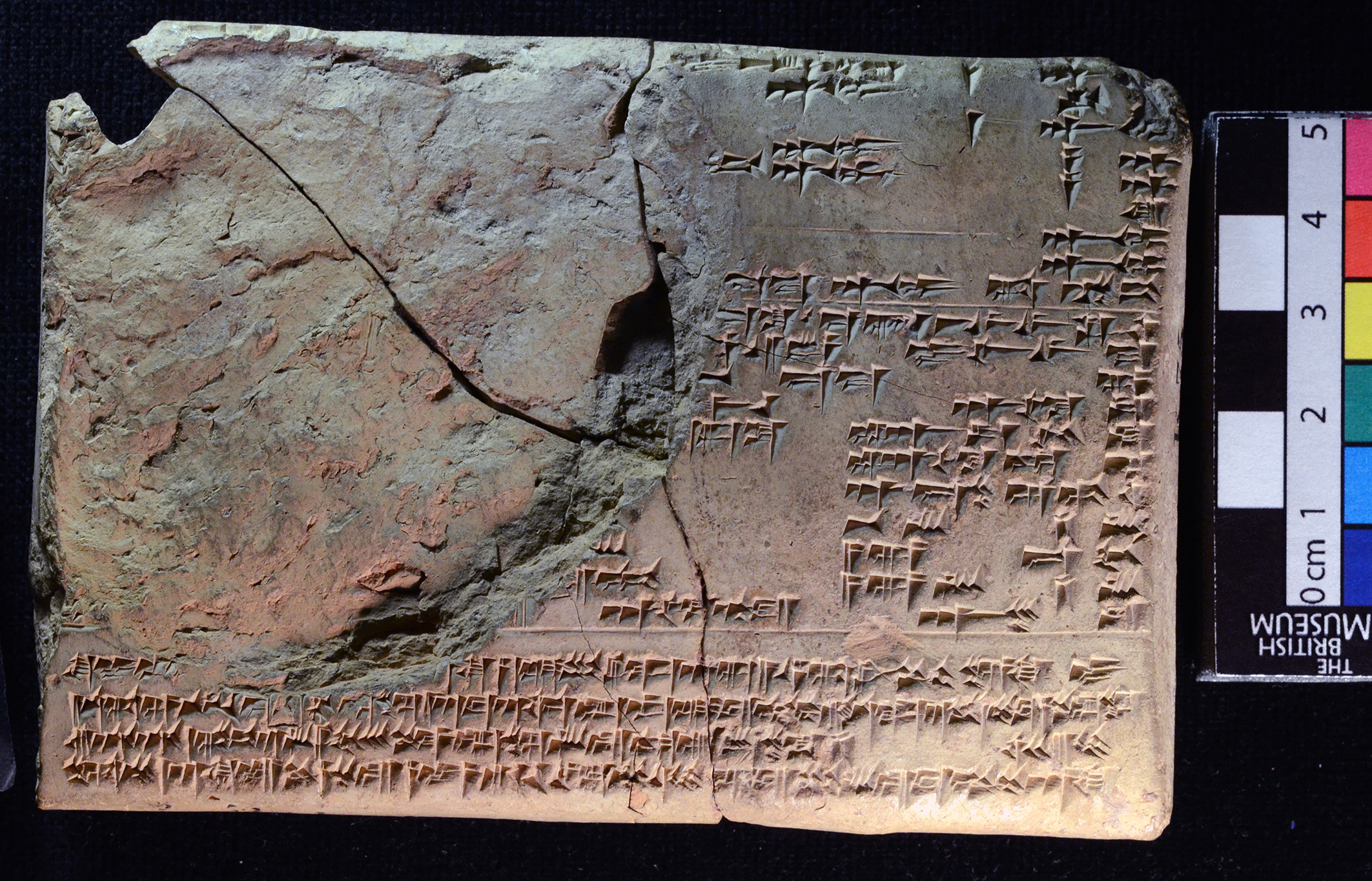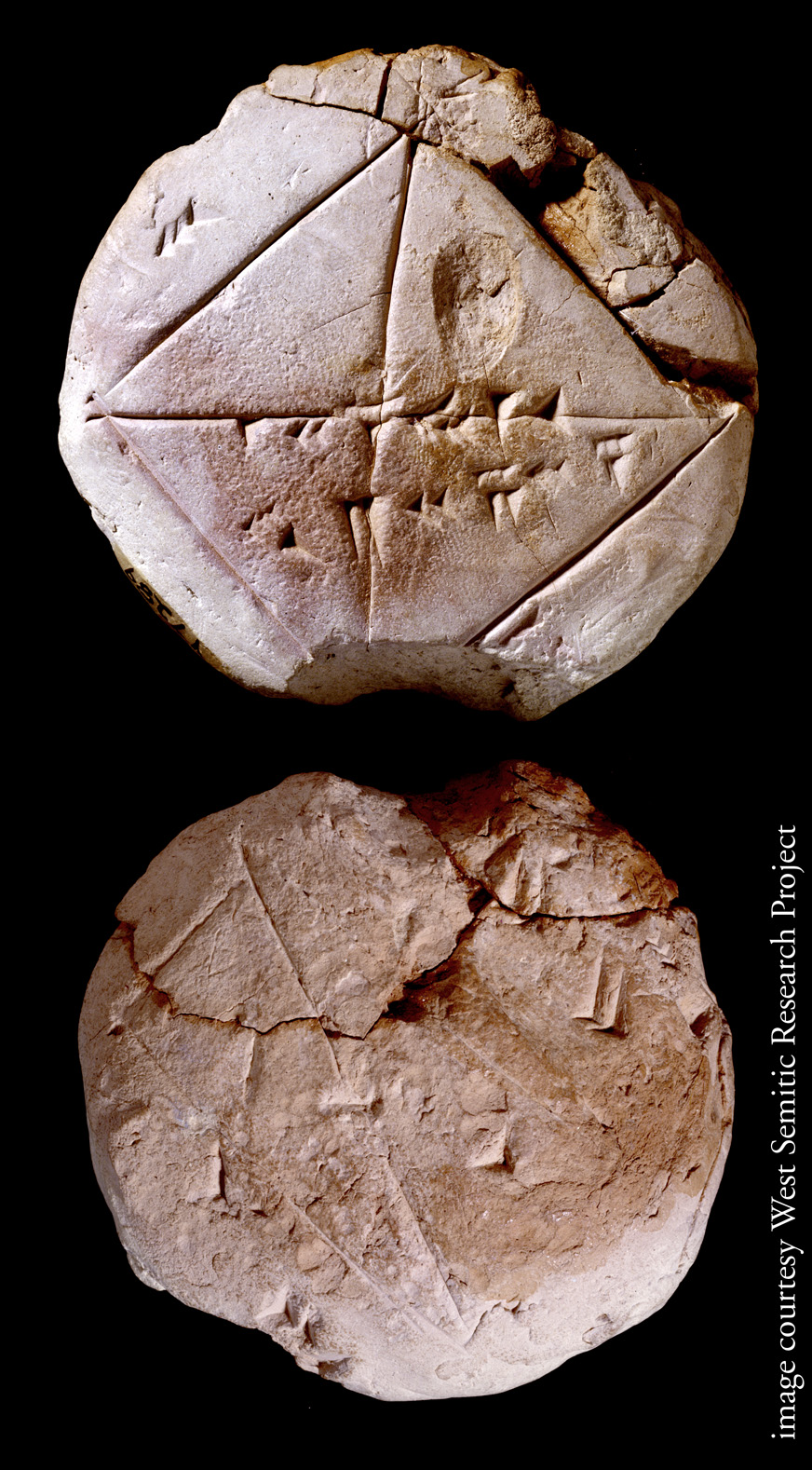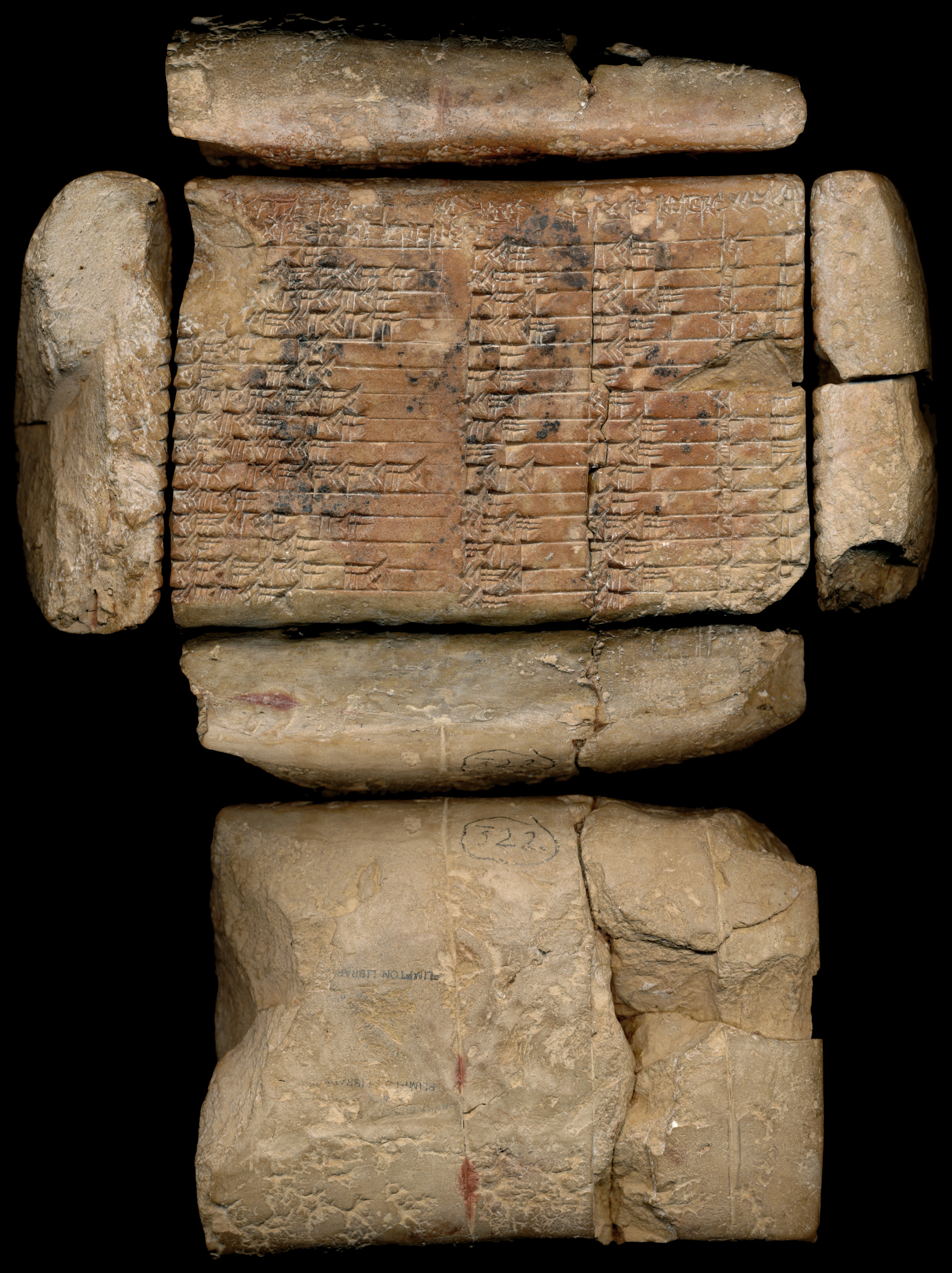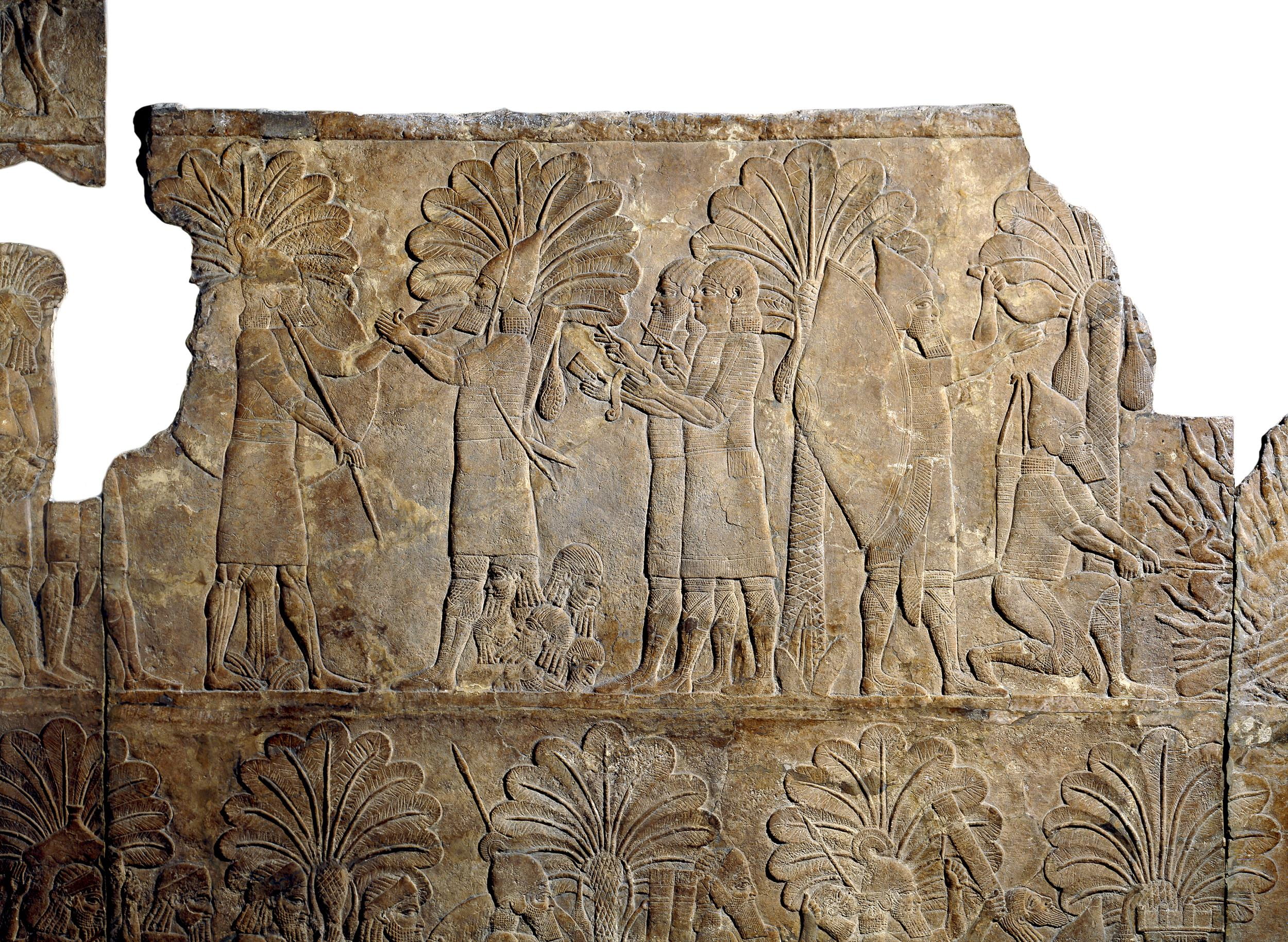By E.L. Meszaros
What does ancient scientific authorship have to teach about the methods and practices of science? Ancient cultures in what is now Iraq and Iran carried out substantial scientific investigations into areas of math, astronomy, medicine, and countless other modern disciplines. We have written works — tablets impressed with the wedges of cuneiform writing — recording everything from astronomical observations to legal agreements. Contrary to modern expectations, however, these texts are often not associated with an author but instead circulate(d) anonymously.
Even when mentioned, Babylonian authors occupy a marginal space in the arrangement of text, identified in colophons rather than on title pages or in neat bylines. These small notes tacked on to the end of texts paint a complex idea of the relationship between authors and texts, often identifying both a scribe and an owner of the tablet. The culture of scribal copying and the different ways that individuals could contribute to a text have all supported ideas of collaborative authorship and allow us to think of a text as an “ongoing, contributive enterprise” (Foster, “On Authorship in Akkadian Literature”). Unlike contemporary research groups, this collective work would be continued, copied, and modified for generations, with each scribal hand a work passed through potentially contributing content, style, and even critique. This is especially evident in the observational program of the Astronomical Diaries, which went on for hundreds of years and must necessarily have been the collaborative work of many different scientists.

We can identify authors of these tablets in other ways as well. Notably, authors sometimes inserted their own names as acrostics, using the first syllabic sign of each line to spell out their name. Assyriologists like to talk about the attributed “divine authorship” of texts as well, an idea which certainly complicates notions of who an author is. Regardless of how you view the idea of divine authorship, the notions of scribe, owner, collective observational programs, and acrostics all point to an idea of authorship that differs from our modern conception.
But the larger problem isn’t just that Babylonian and modern authorship differ. Rather, we must contend with the fact that in most cases we have no idea who the authors of any given Babylonian scientific text actually are. While Assyriologist W. G. Lambert writes that the “overwhelming majority of Babylonian texts circulated anonymously,” Babylonian scientific texts are perhaps particularly characterized, according to Markham Geller, by their anonymity. But the term “anonymous” carries a lot of weight in the modern context, when it is a specific choice or statement meant to indicate something about the content of a piece. When we talk about anonymous Babylonian scientific texts, however, “anonymous” could be viewed as the default form of authorship. Relying on modern conceptions of anonymity might muddy the truth of what’s actually happening with authorship of Babylonian scientific texts and how we should think about attributing knowledge production in the ancient Near East.
Anonymity of Babylonian Scientific Texts
Assumptions around anonymity are entangled with research methods and play a role in assigning value to documents that attest to Babylonian scientific culture. The modern value of authorial attribution appears in questions of priority, asking who discovered or invented an idea first. Priority questions have plagued the history of science, and they make sense in a culture where the identification of authorship and association with new developments is privileged. We also see modern standards of authorship at play in narratives of genius, where large-scale steps or important contributions are attributed to one person. Priority and genius narratives are problematic for a modern history of science, but become even more of an issue when brought back to the study of Babylonian scientific texts, where cultures of anonymity and authorship differ substantially from modern ideas.
We can see ideas of modern scientific authorship at odds with Babylonian anonymity in how certain ancient texts and methods have been treated by modern scholars. Take, for example, Tablet YBC 7829. This mathematical text, from the Yale Babylonian Collection, shows a square crossed by two diagonal lines along with some cuneiform writing. Outside the square are 3 v-shaped wedges indicating that the sides of the square measure 30. The center of the square contains two lines of numbers, the first providing a sexagesimal value for the square root of 2, and the second 30 times that value.

Those familiar with geometry may recognize this as an example of the Pythagorean theorem at work. Perhaps unsurprisingly attributed to the Greek philosopher and mathematician Pythagoras, this theorem defines the square of the length of the long side of a triangle as the sum of the square of its sides. It may be more familiar as:
a² + b² = c²
Or, in the case of this tablet, 30² + 30² = x², which we can solve as 1800 = x², giving us 30√2 = x. (Although, of course, reducing YBC 7829 to such a formula is disingenuous.)
The problem of anonymity becomes evident with this application: can we ask if people, centuries before Pythagoras, were using “Pythagoras’ theorem?” In the absence of an identified author on this tablet, however, what is the best way of contesting this strange priority-assertion? The anonymous nature of YBC 7829 contributes to the treatment of this tablet in Greek terms. Similarly, since the irrational square root of 2 proved so important in the history of Greek mathematics, many scholars placed undue importance on its representation on Babylonian tablets. YBC 7829 is held as a special example of unique knowledge, when in reality the tablet is likely nothing more than an exercise done by a trainee scribe. The weight and importance of representing √2 doesn’t come from Babylonian mathematical culture, but rather from ours.

We have further evidence that Babylonian mathematicians understood this relationship between the lengths of the sides of a triangle. Plimpton 322 shows a table of numerical cuneiform data that fit the Pythagorean Theorem. Often called “Pythagorean Triples,” these numbers are integer solutions for a, b, and c in the formula a² + b²= c². It is clear from these examples that Babylonian scientists — mathematicians, if you feel the need to disambiguate — understood the relationship between the lengths of a triangle’s sides.
The question of priority plagues the analysis of these tablets, however, especially in the eyes of the modern media who cannot seem to stop asking which culture had these ideas first. Their approach frames an understanding of Babylonian math and science with Greek culture, forcing us to examine Babylonian contributions through a Greek lens. But this view is artificial and necessarily a-historic, and is aided by an inability to push back with a Babylonian alternative to Pythagoras due to the anonymity of these ideas. These tablets suggest that a different approach to knowledge is possible, one that engages with scientific discourse without recourse to self-identification. As such, these contributions are better understood when removed from the framework of “Pythagoras,” “trigonometry,” and priority in general.
Priority inserts itself into the study of Babylonian science in other ways. Systems A and B are two different methods for calculating when a phenomenon like the first visibility of a planet will occur and where it will be located in the sky when it does. System A, usually called a “step function,” adds constant values to a time and location to find the next time and the next location. Most planets have a few constant values, depending on what part of the sky they are in. System B, the “zig-zag function,” adds a constantly changing value to previous time and location.
The complexity of these Systems suggested to some scholars that they were the creation not of the collaborative efforts of many astronomers over a period of time, but rather the inventions of a genius. For some decades, scholars sought to identify these “geniuses” and attribute authors to both of these systems, landing on Nabû-rēmanni for system A, and Kidinnu for system B. Each of these names is supported by an appearance in a tablet’s colophon (Neugebauer, “The Alleged Babylonian Discovery of the Precession of the Equinoxes”), though, importantly, there is very little evidence for either name.
The most interesting aspect of these authors is how they are identified. Rather than the expected scribe or tablet owner, colophons have identified texts as “computed table of” Kidinnu and Nabû-rēmanni (Ossendrijver, Babylonian Mathematical Astronomy). This led to the theory that Kidinnu and Nabû-rēmanni are instead the contributors of the theory used to create the data contained on the tablet — the “geniuses” responsible for Systems A and B. This focus is misplaced, however, in that it asks us to accept not only poorly attested identities of these “geniuses” but also to look for attested creators within a culture that does not seem to have privileged such information. Questions of priority and genius falter against the anonymous contributions of the ancient Near East — not only are they hard to answer but they might be the wrong questions to ask.
Disentangling Ideas of Authorship
The search for priority in the Babylonian scientific context is often a-historical. Worse, by seeking out individuals to credit with entire theories, our modern biases often influence who we look for in the historical record, often seeking out upper class, male contributors. Pushing back against the genius, individual author and looking instead for collaborative work taking place over time may create more space for women in the authorship of Babylonian science. We know, for instance, that women could be astronomers and scholars, knowledgeable in cuneiform writing, even though most of the recorded Babylonian “authors” were male. Relying only on these noted “scribes” and “owners” erases the role that women may have played in observational programs and the long collaborative and contributive enterprise of Babylonian authorship.
The search for “authorship” of Babylonian science texts is flavored by modern conceptions of how authorship should work. Naive ideas that priority matters, that work should be associated with individuals rather than communities, and that anonymity is rare and, thus, inherently meaningful, all distract from understanding authorship as Babylonian scientists would have. We should acknowledge the complexity of the modern author while working to disentangle modern meanings from ancient ideas of authorship. We can then complicate the narrative of scientific authorship in both directions, enabling historians and historians of science to reshape how we think and talk about authors, but also encouraging a less-broad view of modern discussions of scientific authorship. Just as we confront changing ideas of what “science” means, we must also contend with shifting ideas of what it means to author scientific knowledge.
Scientific Anonymity in the Modern Age
The institutions of (modern) science privilege originality and require named contributions. Anonymity, when it’s used, is a conscious choice. Mary Terrall, in “The Uses of Anonymity in the Age of Reason,” describes how the anonymity of the Paris Academy of Sciences prize allowed the Marquise de Châtelet to submit her work without declaring her gender, a boon in times when women were not often allowed in scientific circles. However, when she did not win she gave up her anonymity to use her station and powerful connections to get her work published.
This shifting use of anonymity suggests some key features of modern anonymous authorship in scientific texts — it was almost always temporary and intended to eventually be breached. Terrall explains that almost without exception “anonymous authors of texts on scientific subjects either unmasked themselves or were unmasked by others within a few years, if not months, of publication.” In this sense, we can talk about modern anonymity in scientific authorship as an unusual and temporary state worthy of note.
Anonymous science becomes even rarer in the present, with professional advancement in labs and academia dependent on evidence of publication. Modern authorship in science becomes a power statement, with the order of authors as they are listed in an article or book frequently indicative of power dynamics within partnerships. The first author position is usually granted the most acclaim, but the last author is usually the person with the most power — the project or lab leader, for example. Such power dynamics are unlikely components of Babylonian scientific texts, but are important components for understanding modern scientific authorship.
We also see anonymity in the authorship of reviews and critique. The anonymous peer review process has become a staple for the publication of research, an apparatus not limited to scientific discourse but certainly foundational to the modern practice of science. Concealing the identities of both a paper’s author and its reviewer is designed for protection and to increase honesty and objectivity, yet often has the effect of reducing credibility and accountability. In fact, while anonymity in the context of peer-review is industry standard, its value and effectiveness have been questioned and found wanting.
Modern scientific authorship is complex — it must necessarily deal with ideas of precarity and the power dynamics at play in how authorship is recorded. But more than this, it has become so ingrained within the institution of science that concepts like the“number of first-authored papers” become important. Coupled with modern conceptions of anonymity in scientific texts, we have a view of how scientific authorship works that is multifaceted and also not always consciously enacted. This is the baggage that we carry with us when we try to examine authorship and knowledge in ancient science.
Associating written works with a specific author (or authors) is second nature in the modern era. It’s not only safe to assume that a piece of recorded knowledge can be attributed to a creator of that knowledge, but practices of citation and promotion require us to acknowledge these creators. Babylonian approaches to scientific authorship prompt us to question our modern ideas of what an author is and why attributive authorship is necessary. Rethinking scientific authorship to incorporate long-term, collaborative enterprise and unremarkable anonymity allows us to better understand ancient scientific texts. It also forces us to confront uncomfortable questions about modern scientific texts, like who gets to claim authorship and who can or must make use of anonymity. These structures are broader and deeper than our modern conceptions, stretching back thousands of years and encompassing necessity, precarity, and manifestations of power in the production of scientific knowledge.
E.L. Meszaros is a PhD student in the History of the Exact Sciences in Antiquity at Brown University. Her research focuses on the language used to talk about science, particularly as this language is transmitted between cultures and across time.
Featured Image: Stone panel from the South-West Palace of Sennacherib, The British Museum.



